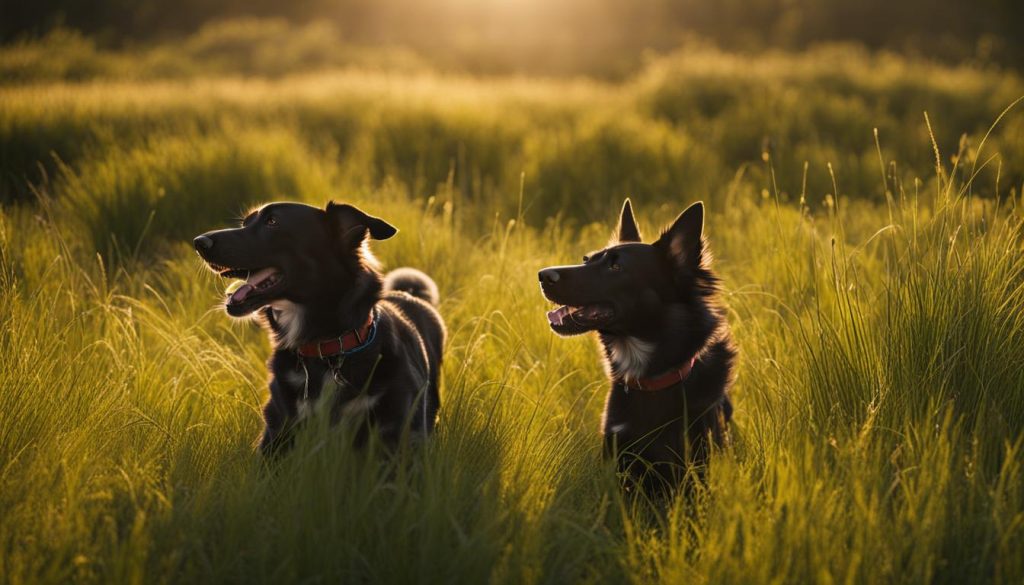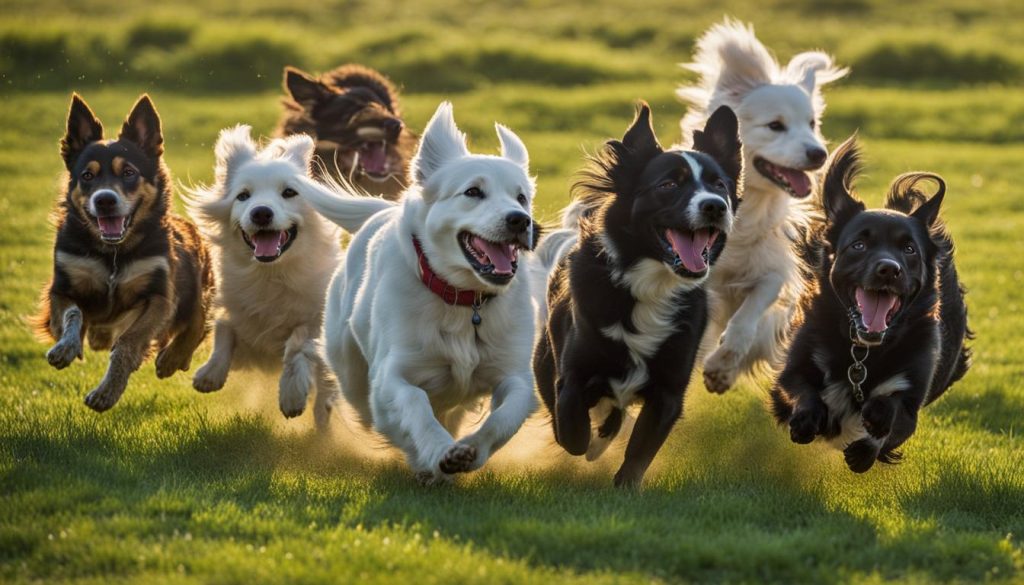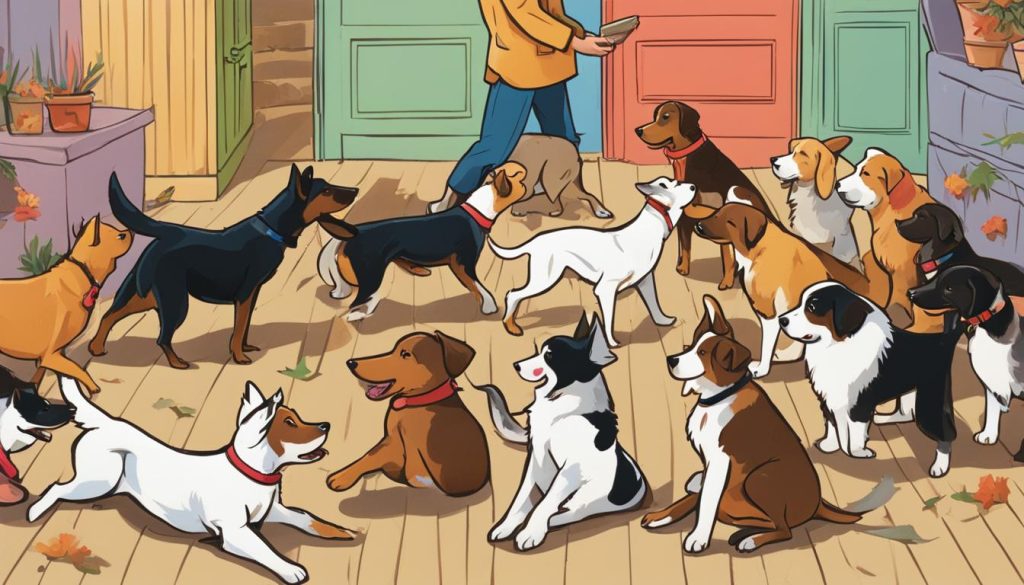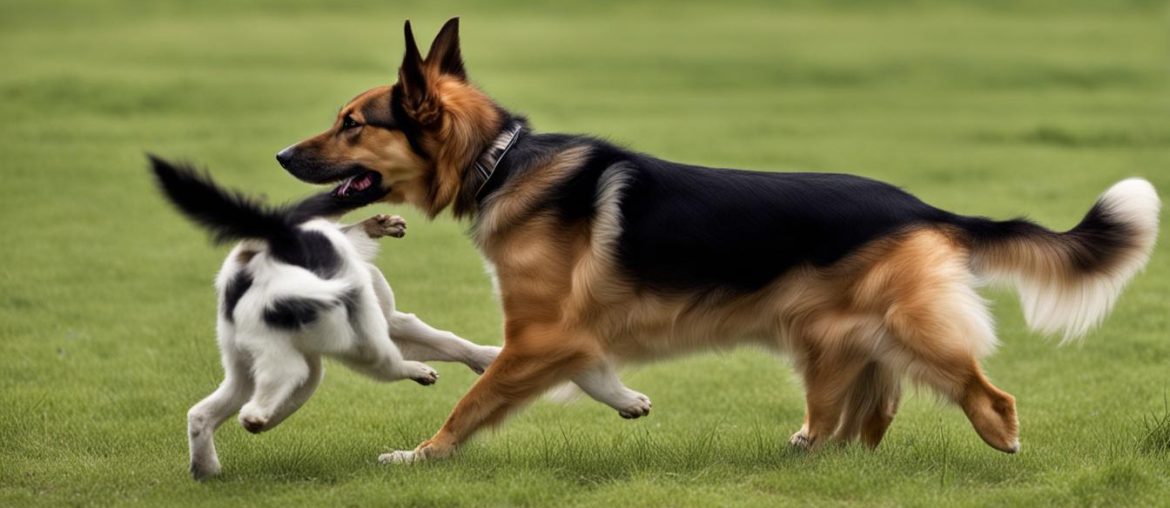Have you ever wondered why dogs walk in circles? It’s a behavior that may seem odd or confusing, but there are actually several reasons why dogs engage in this circular motion. Understanding this behavior can help us better understand our furry friends and ensure their well-being.
When dogs walk in circles, it is often a sign of forebrain dysfunction. This can be caused by various underlying factors such as brain tumors, strokes, inflammation of the brain, or hydrocephalus. If you notice your dog engaging in this behavior, it is crucial to seek veterinary attention to determine the underlying cause and provide appropriate care.
Key Takeaways:
- Dogs walking in circles can indicate forebrain dysfunction.
- Neurologic causes for circle walking include brain tumors, strokes, inflammation of the brain, and hydrocephalus.
- Instinctive behavior and gestures of affection can also cause dogs to walk in circles.
- Senior dogs and dogs experiencing discomfort may exhibit excessive circle walking.
- Understanding canine behavior helps ensure the overall well-being of our furry friends.
Forebrain Dysfunction in Dogs
Dogs walking in circles is often a symptom of forebrain dysfunction. This condition can manifest with various accompanying symptoms such as seizures, behavior changes, head pressing, or even blindness. Dogs with forebrain dysfunction tend to walk in circles around a room rather than tightly circling in one place like those with brainstem disease. While circling can also be a learned behavior, sudden and repetitive circling without any apparent reason is concerning and should be investigated further.
Forebrain dysfunction in dogs can be caused by various neurologic conditions such as brain tumors, strokes, inflammation of the brain, or hydrocephalus. Brain tumors can lead to abnormal cell growth and destruction of healthy tissue, resulting in the dysfunction of the forebrain. Strokes occur when the blood flow to the brain is obstructed or a blood vessel bursts, leading to forebrain dysfunction. Inflammation of the brain, such as encephalitis or meningitis, can also cause circling behavior. Additionally, hydrocephalus, which is characterized by fluid buildup and swelling in the brain, can result in circle walking and other forebrain dysfunction symptoms.
If you observe your dog walking in circles, it is crucial to seek veterinary attention to determine the underlying cause and provide appropriate treatment. A thorough examination and diagnostic tests may be necessary to identify the specific neurologic condition affecting your dog. Early detection and intervention can greatly improve the prognosis and quality of life for dogs with forebrain dysfunction.
| Neurologic Causes of Circle Walking in Dogs | Symptoms |
|---|---|
| Brain tumors | Abnormal cell growth, destruction of healthy tissue |
| Strokes | Obstruction of blood flow to the brain, blood vessel burst |
| Inflammation of the brain | Encephalitis, meningitis |
| Hydrocephalus | Fluid buildup, brain swelling |
Neurologic Causes of Circle Walking in Dogs
Circle walking in dogs can be attributed to various neurologic causes. These conditions can affect the brain and lead to abnormal behaviors such as continuous circling. It is important for dog owners to be aware of these potential causes and seek veterinary attention for proper diagnosis and treatment.
The most common neurologic causes of circle walking in dogs include brain tumors, strokes, inflammation of the brain, and hydrocephalus. Brain tumors can cause abnormal cell growth and destruction of healthy brain tissue, leading to forebrain dysfunction. Strokes occur when blood flow to the brain is obstructed or a blood vessel bursts, resulting in brain damage and neurologic symptoms, including the tendency to walk in circles. Inflammation of the brain, such as encephalitis or meningitis, can also cause circling behavior. Hydrocephalus, characterized by fluid buildup in the brain, can result in circle walking and other forebrain dysfunction symptoms.
When a dog displays continuous circle walking, it is crucial to consult with a veterinarian to identify the underlying cause. The veterinarian will perform a thorough examination and may recommend additional diagnostic tests, such as imaging scans or blood work, to confirm the diagnosis. Early detection and proper treatment can greatly improve the dog’s quality of life and prevent further progression of the neurologic condition.
Table: Neurologic Causes of Circle Walking in Dogs
| Neurologic Cause | Description |
|---|---|
| Brain Tumor | Abnormal cell growth in the brain, leading to forebrain dysfunction |
| Stroke | Obstruction of blood flow to the brain or rupture of a blood vessel, resulting in brain damage |
| Inflammation of the Brain | Encephalitis or meningitis causing brain inflammation and abnormal behaviors |
| Hydrocephalus | Fluid buildup in the brain, leading to forebrain dysfunction and circle walking |
Understanding the neurologic causes of circle walking in dogs is essential for pet owners to recognize the potential underlying conditions and seek appropriate veterinary care. By addressing the root cause, dog owners can help their furry companions receive the necessary treatment and improve their overall well-being.
Instinctive Behavior: Circling before Resting

One common behavior observed in dogs is circling before settling down to rest. This instinctive behavior can be traced back to their ancestors, such as wolves. In the wild, wolves would circle their sleeping area to flatten the grass, create a comfortable spot, and check for potential threats. Domesticated dogs still retain this innate behavior, as they instinctively dig little burrows in the ground to lie in and ensure their sleeping area is safe.
This circling behavior serves multiple purposes for dogs. It helps them create a comfortable sleeping spot by flattening the area and potentially removing any debris. It also allows them to assess their surroundings and ensure they are secure before settling down. This instinctive behavior is deeply ingrained in dogs and is often performed without conscious thought.
It’s important for dog owners to understand and respect this instinctive behavior. Providing dogs with a designated sleeping area, such as a comfortable bed or crate, can help satisfy their instinctual need to create a safe and secure resting spot. Observing and appreciating this behavior can deepen the bond between dogs and their owners.
Table: Instinctive Behavior in Dogs
| Behavior | Description |
|---|---|
| Circling before resting | Dogs instinctively circle their sleeping area to create a comfortable spot and check for potential threats. |
| Digging before lying down | Dogs dig or scratch at their sleeping area to create a safe and secure spot for resting. |
| Burying food | Dogs may bury excess food as an instinctual behavior to preserve it for later and hide it from potential scavengers. |
| Pawing or scratching | Dogs may scratch at the ground or surfaces as a way to mark their territory and communicate with other dogs. |
Circling before Defecation
Dogs often exhibit a peculiar behavior of walking in circles before they defecate. This may seem odd to us humans, but it actually serves a purpose in their canine world. When dogs engage in this circling behavior, they are instinctively gathering information through scent.
Walking in circles stimulates movement in their intestines, aiding in the elimination process. Additionally, the scent of previous bowel movements encourages dogs to use the same spot for their current elimination, creating a familiar and preferred location.
Circling before defecation can also be a way for dogs to maximize the amount of scent they leave behind. By circling, they are effectively marking their territory and communicating with other dogs in the area.
| Reasons for Circling Before Defecation | Explanation |
|---|---|
| Gathering Information | Dogs use their highly developed sense of smell to gather information about their surroundings and potential threats. |
| Stimulating Intestines | Walking in circles helps stimulate movement in their intestines, aiding in the elimination process. |
| Marking Territory | By circling before defecating, dogs leave behind their scent as a way of marking their territory and communicating with other dogs. |
So, the next time you see your dog walking in circles before they do their business, remember that it’s just their natural instinct at work. It’s a fascinating glimpse into the intricate world of canine behavior and communication.
Spinning in Circles when Excited

When it comes to canine behavior, dogs have a unique way of expressing their excitement—spinning in circles. This high-energy behavior is often seen when dogs greet their owners, meet new people, or anticipate playtime. Spinning in circles is a natural release of excess energy and a joyful expression.
Dogs’ spinning behavior can also be linked to their ancestral instincts. As descendants of hunting and herding canines, dogs may spin as a way to channel their innate chasing and herding instincts. This behavior reflects their natural inclination to move quickly and engage in physical activity.
However, it’s essential to distinguish between normal spinning behavior and excessive or repetitive spinning. Excessive spinning or chasing the tail can be a sign of canine compulsive disorder or even epileptic seizures. If you notice your dog engaging in extreme spinning behaviors, it’s important to consult with a veterinarian for a proper evaluation and guidance.
Understanding and appreciating the many ways dogs express their emotions can deepen the bond between dogs and their human companions. Spinning in circles when excited is just one of the fascinating behaviors that make dogs unique and endearing. As responsible pet owners, it’s crucial to provide appropriate outlets for their energy and seek professional advice if behaviors become excessive or concerning.
Circling as a Gesture of Affection or Curiosity

Dogs have a unique way of expressing their affection and curiosity, often through their body language. One common behavior is circling around people, which can be seen as a gesture of affection and a desire to be close to their human companions. When a dog circles around you, they are not only investigating their surroundings but also showing their interest and bond with you.
This behavior is typically seen as endearing and is often exhibited by various dog breeds. It is their way of saying, “I want to be near you,” and it can be seen as a form of attention-seeking behavior. Dogs may also circle people as a gesture of curiosity, wanting to understand and explore the individuals they interact with.
It’s important to note that circling around people can also be seen in herding breeds such as collies. These dogs have a natural instinct to herd, and circling can be their way of trying to “herd” their owners or other people. This behavior is deeply ingrained in their genetic makeup and should be understood as part of their natural instincts.
Table: Common Signs of Affection in Dogs
| Signs of Affection | Description |
|---|---|
| Tail wagging | A wagging tail can indicate happiness and excitement in dogs. |
| Licking | Licking is a way for dogs to show affection and groom their loved ones. |
| Leaning against you | Dogs often lean against their owners as a way to seek comfort and closeness. |
| Offering their belly | A dog exposing their belly is a sign of trust and submission, showing that they feel safe and secure. |
| Circling around people | Circling can be a way for dogs to investigate and show their affection towards their owners. |
Understanding the various ways that dogs express their affection can deepen the bond between humans and their four-legged friends. It is important to recognize and appreciate these gestures, as they are an integral part of the canine-human relationship.
Circle Walking in Senior Dogs

When it comes to circle walking in senior dogs, it is important to understand that this behavior can be indicative of underlying health issues. As dogs age, they are more susceptible to forebrain dysfunction, dementia, strokes, brain inflammation, hydrocephalus, vestibular syndrome, or brain tumors. These conditions can disrupt their balance and coordination, causing them to walk in circles. If you notice your senior dog engaging in repetitive or prolonged circle walking, it is crucial to consult a veterinarian for a thorough examination and appropriate diagnosis.
Senior dogs are more prone to age-related conditions that can affect their mobility and cognitive function. Forebrain dysfunction, which is often associated with circling behavior, can result from various neurological issues and should be addressed promptly. Additionally, strokes and brain tumors can cause significant changes in a dog’s behavior, including circle walking. By seeking veterinary attention, you can ensure that your senior dog receives the necessary care and treatment to improve their quality of life.
While circle walking in senior dogs may be a cause for concern, it is essential to rule out any potential health issues before jumping to conclusions. Depending on the diagnosis, treatment options may include medication, physical therapy, or supportive care to manage symptoms and slow down disease progression. By closely monitoring your senior dog’s behavior and seeking professional advice, you can provide them with the care they need and deserve during their golden years.
| Potential Causes of Circle Walking in Senior Dogs | Symptoms |
|---|---|
| Forebrain Dysfunction | Seizures, behavior changes, head pressing, blindness |
| Dementia | Confusion, disorientation, memory loss |
| Strokes | Loss of balance, weakness on one side of the body, disorientation |
| Brain Inflammation | Head pressing, fever, lethargy, seizures |
| Hydrocephalus | Head enlargement, seizures, balance issues |
| Vestibular Syndrome | Head tilt, loss of balance, uncontrollable eye movements |
| Brain Tumors | Changes in behavior, seizures, weakness |
As pet owners, it is our responsibility to provide the best care for our senior dogs. If you observe any concerning behaviors like circle walking, do not hesitate to consult a veterinarian who can assess your dog’s condition and recommend appropriate steps to manage and improve their overall well-being. By addressing these issues promptly, you can help your senior dog enjoy a comfortable and fulfilling life in their golden years.
Comfort and Habitual Circling

Some dogs engage in circling behavior as a way to make their sleeping area comfortable. They may scratch at their beds or circle multiple times before settling down. This instinctive behavior comes from their ancestors, such as wolves, who would circle their sleeping area to flatten the grass and create a secure spot. While circling before settling down is generally normal, excessive or obsessive circling could indicate discomfort or underlying issues.
If you notice your dog excessively circling or displaying repetitive behavior patterns, it is advisable to consult a veterinarian. Excessive circling can be a sign of discomfort, pain, or a medical condition. Our furry friends cannot communicate their discomfort directly to us, so it is essential to seek professional advice to ensure their well-being. A veterinarian will be able to examine your dog, conduct any necessary tests, and provide appropriate treatment or management options.
Additionally, habitual circling can sometimes be caused by anxiety or stress. Dogs may exhibit this behavior when they are in unfamiliar environments, experiencing separation anxiety, or feeling overwhelmed. If you suspect your dog’s circling is related to anxiety, it is important to address the underlying cause. Consultation with a veterinarian or a professional dog behaviorist can help identify the triggers and develop a tailored plan to reduce anxiety and promote a sense of security for your furry companion.
| Causes of Excessive Circling in Dogs | Symptoms |
|---|---|
| Ear infections | Head shaking, discharge, foul odor |
| Vestibular syndrome | Balance issues, head tilt, uncoordinated movement |
| Orthopedic problems | Limping, difficulty getting up or lying down |
| Neurological disorders | Seizures, loss of coordination, behavior changes |
“Understanding why dogs circle can help us provide appropriate care and ensure their overall well-being.” – Dr. Jessica Thompson, DVM
Understanding Canine Behavior

Understanding the behavior of our canine companions is essential for providing them with the care and attention they need. Dogs have inherited certain behaviors and instincts from their ancestors, such as wolves, which influence their actions and reactions in various situations. By recognizing these genetic predispositions, we can gain valuable insight into our furry friends’ behavior.
Dogs display a range of instinctive behaviors, including circling before resting or defecating, which can be traced back to their ancestral roots. These behaviors are ingrained in their genetic makeup and serve specific purposes. For example, circling before settling down to rest is a way for dogs to create a comfortable sleeping area and ensure their safety. Similarly, walking in circles before defecating allows dogs to gather information through scent and mark their territory.
While instinctive behaviors play a significant role in canine behavior, it’s important to note that not all circle walking is natural or normal. In some cases, circling can be a sign of forebrain dysfunction, neurologic issues, or even expressions of emotion. It’s essential for pet owners to be able to distinguish between normal behavior and abnormal patterns, seeking veterinary guidance when necessary to ensure the well-being of their furry companions.
Wrapping Up
To sum up, canine circle walking behavior can be indicative of various underlying causes. Abnormal circling patterns may be a symptom of forebrain dysfunction, neurologic issues, or a result of instinctive behavior or emotional expression. If you observe your dog walking in circles, particularly if it is repetitive or sudden, it is essential to seek veterinary advice to identify the root cause.
Forebrain dysfunction, such as brain tumors, strokes, inflammation of the brain, or hydrocephalus, can lead to abnormal circling behavior in dogs. Additionally, dogs may exhibit instinctive behaviors inherited from their ancestors, like circling before resting or defecating. This serves as a way to create a comfortable sleeping area or gather scent information.
Understanding canine behavior and recognizing abnormal patterns is crucial for responsible pet ownership. Regular veterinary check-ups and maintaining a comprehensive understanding of your dog’s behavior will promote their overall well-being and ensure prompt intervention when necessary.
FAQ
Is it normal for dogs to walk in circles?
No, walking in circles is usually not considered normal behavior in dogs.
What can walking in circles be a sign of in dogs?
Walking in circles can be a sign of forebrain dysfunction in dogs.
What are some other symptoms of forebrain dysfunction in dogs?
Other symptoms of forebrain dysfunction can include seizures, behavior changes, head pressing, or blindness.
What are the common neurologic causes of circle walking in dogs?
The common neurologic causes of circle walking in dogs are brain tumors, strokes, inflammation of the brain, and hydrocephalus.
Why do dogs walk in circles before resting?
Dogs walk in circles before resting as an instinctive behavior inherited from their ancestors, such as wolves.
Why do dogs walk in circles before defecating?
Dogs walk in circles before defecating to gather information through scent and mark their territory.
Why do dogs spin in circles when excited?
Dogs may spin in circles when excited as a way to release excess energy and express joy.
Why do dogs circle around people?
Dogs may circle around people as a way to investigate, show affection, or in some cases, try to “herd” them.
Can circle walking in senior dogs indicate underlying health issues?
Yes, circle walking in senior dogs can indicate underlying health issues such as forebrain dysfunction, dementia, strokes, or brain tumors.
Why do dogs circle before settling down?
Dogs may circle before settling down to make their sleeping area comfortable. However, excessive circling could be a sign of discomfort.
How can understanding canine behavior help pet owners?
Understanding canine behavior helps pet owners recognize normal and abnormal behaviors and seek appropriate care for their furry friends.






